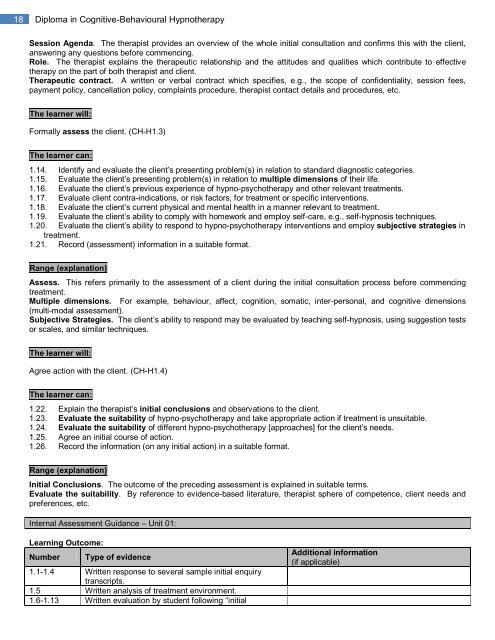Diploma in Cognitive-Behavioural Hypnotherapy - REBHP
Diploma in Cognitive-Behavioural Hypnotherapy - REBHP
Diploma in Cognitive-Behavioural Hypnotherapy - REBHP
Create successful ePaper yourself
Turn your PDF publications into a flip-book with our unique Google optimized e-Paper software.
18 <strong>Diploma</strong> <strong>in</strong> <strong>Cognitive</strong>-<strong>Behavioural</strong> <strong>Hypnotherapy</strong>Session Agenda. The therapist provides an overview of the whole <strong>in</strong>itial consultation and confirms this with the client,answer<strong>in</strong>g any questions before commenc<strong>in</strong>g.Role. The therapist expla<strong>in</strong>s the therapeutic relationship and the attitudes and qualities which contribute to effectivetherapy on the part of both therapist and client.Therapeutic contract. A written or verbal contract which specifies, e.g., the scope of confidentiality, session fees,payment policy, cancellation policy, compla<strong>in</strong>ts procedure, therapist contact details and procedures, etc.The learner will:Formally assess the client. (CH-H1.3)The learner can:1.14. Identify and evaluate the client‘s present<strong>in</strong>g problem(s) <strong>in</strong> relation to standard diagnostic categories.1.15. Evaluate the client‘s present<strong>in</strong>g problem(s) <strong>in</strong> relation to multiple dimensions of their life.1.16. Evaluate the client‘s previous experience of hypno-psychotherapy and other relevant treatments.1.17. Evaluate client contra-<strong>in</strong>dications, or risk factors, for treatment or specific <strong>in</strong>terventions.1.18. Evaluate the client‘s current physical and mental health <strong>in</strong> a manner relevant to treatment.1.19. Evaluate the client‘s ability to comply with homework and employ self-care, e.g., self-hypnosis techniques.1.20. Evaluate the client‘s ability to respond to hypno-psychotherapy <strong>in</strong>terventions and employ subjective strategies <strong>in</strong>treatment.1.21. Record (assessment) <strong>in</strong>formation <strong>in</strong> a suitable format.Range (explanation)Assess. This refers primarily to the assessment of a client dur<strong>in</strong>g the <strong>in</strong>itial consultation process before commenc<strong>in</strong>gtreatment.Multiple dimensions. For example, behaviour, affect, cognition, somatic, <strong>in</strong>ter-personal, and cognitive dimensions(multi-modal assessment).Subjective Strategies. The client‘s ability to respond may be evaluated by teach<strong>in</strong>g self-hypnosis, us<strong>in</strong>g suggestion testsor scales, and similar techniques.The learner will:Agree action with the client. (CH-H1.4)The learner can:1.22. Expla<strong>in</strong> the therapist‘s <strong>in</strong>itial conclusions and observations to the client.1.23. Evaluate the suitability of hypno-psychotherapy and take appropriate action if treatment is unsuitable.1.24. Evaluate the suitability of different hypno-psychotherapy [approaches] for the client‘s needs.1.25. Agree an <strong>in</strong>itial course of action.1.26. Record the <strong>in</strong>formation (on any <strong>in</strong>itial action) <strong>in</strong> a suitable format.Range (explanation)Initial Conclusions. The outcome of the preced<strong>in</strong>g assessment is expla<strong>in</strong>ed <strong>in</strong> suitable terms.Evaluate the suitability. By reference to evidence-based literature, therapist sphere of competence, client needs andpreferences, etc.Internal Assessment Guidance – Unit 01:Learn<strong>in</strong>g Outcome:NumberType of evidence1.1-1.4 Written response to several sample <strong>in</strong>itial enquirytranscripts.1.5 Written analysis of treatment environment.1.6-1.13 Written evaluation by student follow<strong>in</strong>g ―<strong>in</strong>itialAdditional <strong>in</strong>formation(if applicable)


